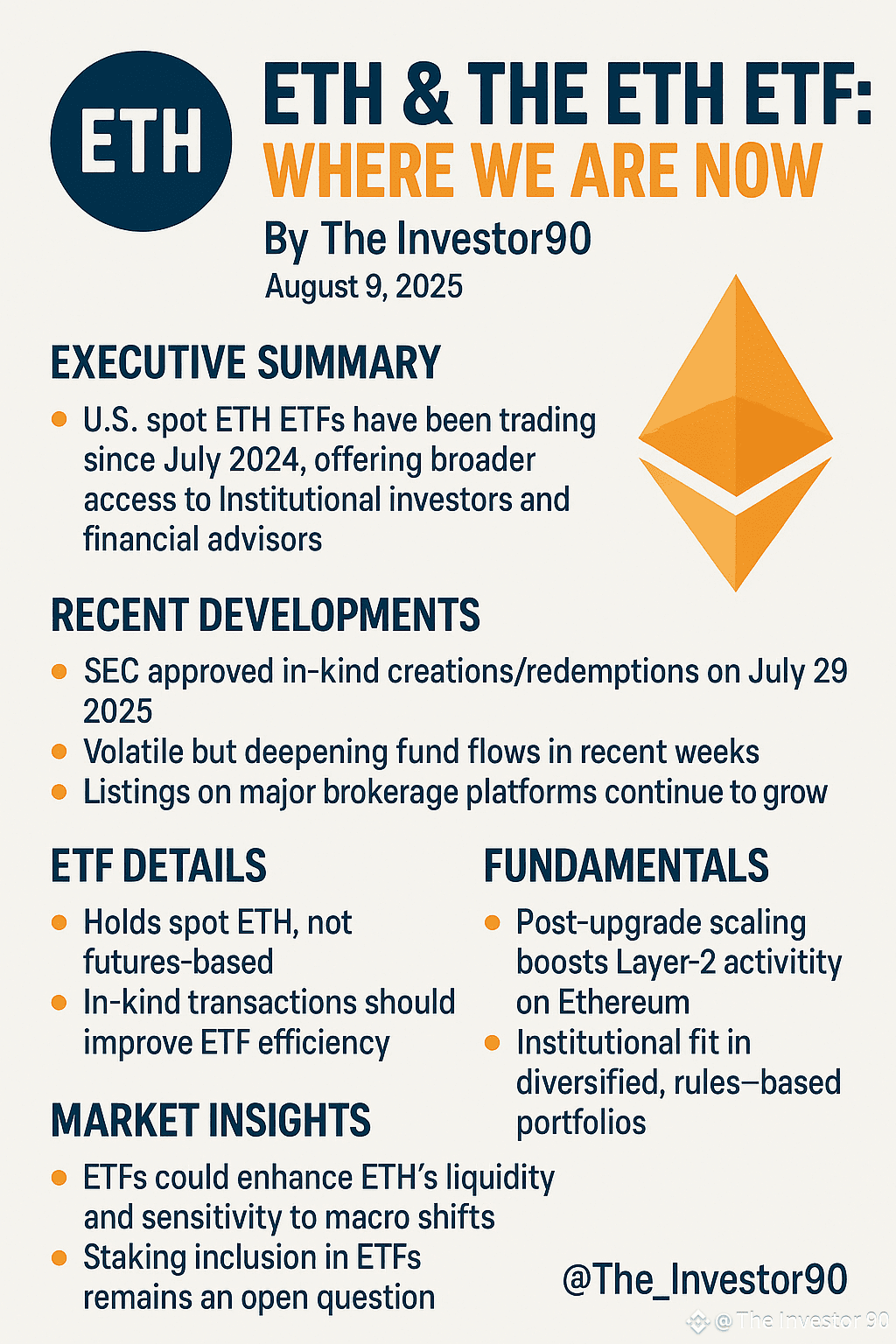ETH & The ETH ETF: Where We Are Now (Aug 9, 2025)
By: The Investor90 — Crypto Market Analyst
Ether’s investment case broadened materially over the last year: the U.S. spot ETH ETFs have been trading since July 2024, giving institutions and advisors a familiar wrapper for ETH exposure. In the past two weeks, the SEC also green-lit “in-kind” creations/redemptions for crypto ETPs—an operational shift that should tighten spreads, lower costs, and improve primary-market plumbing for both BTC and ETH products.
What changed lately (and why it matters)
In-kind creates/redeems approved (Jul 29, 2025). APs can now deliver/receive ETH directly rather than cash when creating or redeeming ETF shares. This typically reduces slippage and tax friction and can make the funds more efficient during volatile windows. Expect tighter tracking and healthier secondary-market liquidity over time.
Flows are volatile—but deepening. U.S. spot ETH ETFs have seen days of heavy outflows as well as renewed inflows, underscoring that the investor base is broadening (and rotating) rather than one-way “new money.” This week included the largest single-day outflow since launch, followed by stabilization—classic behavior when macro headlines are noisy.
Mainstream access keeps expanding. Major brokerages and wealth platforms continue listing spot ETH ETFs; educational coverage now treats them as standard portfolio tools (with higher risk). That structural access is a medium-term tailwind for allocations from RIAs and model portfolios.
ETH ETF: how it works (quick refresher)
What it holds: The U.S. products hold spot ether in custody; they’re not futures-based. They track ETH’s market price minus fees and operational frictions.
Why “in-kind” matters: Letting APs hand over/receive ETH instead of cash can improve tracking, spreads, and tax efficiency, particularly when funding markets are tight or ETH’s price is moving fast.
Where to follow them: Public trackers provide fund lists, tickers, AUM, and daily flows—invaluable for reading sentiment beyond spot charts.
ETH fundamentals to watch
Post-Dencun scaling effects: L2s keep absorbing activity; reduced data costs (from EIP-4844) underpin healthier usage economics. This supports the narrative that Ethereum blockspace is getting cheaper while capacity grows—important for cash-flow-based valuation frameworks (fees, burn, network usage). (Background—general knowledge; no single new source required.)
Institutional fit: The ETF wrapper lets allocators bundle ETH into balanced, rules-based models and tax-managed sleeves, expanding the potential buyer base beyond crypto-native venues.
Market implications
Liquidity flywheel: More efficient primary markets (post in-kind approval) tend to tighten ETF spreads, draw arbitrage capital, and lower the cost of entry—which can amplify ETH’s responsiveness to macro catalysts (rates, risk appetite) and to crypto-native catalysts (L2 activity, staking flows).
Flows ≠ price, but they matter: Episodes of large outflows remind us ETFs are two-way pipes; they can transmit macro de-risking into crypto quickly, but they also re-accelerate when risk appetite returns. Monitoring net creations across all issuers offers a cleaner read on institutional sentiment than price alone.
Risks & open questions
Staking in ETFs? U.S. ETH ETFs do not stake today. Whether the SEC will ever allow staking inside a ’40-Act or similar vehicle remains unsettled; several analyses see legal/operational hurdles even after in-kind relief. If allowed in the future, staking yield could improve total return and change competitive dynamics versus holding ETH directly.
Policy & macro: Tariff-driven growth jitters, rate-cut timing, and cross-asset safe-haven rotations (e.g., into gold) can whipsaw flows in risk assets, including crypto ETPs. 2025’s record-pace ETF allocations show capital is active and tactical.
How I’m tracking it (playbook)
1. Daily ETF flows & spreads: Use an aggregator (Blockworks tracker) plus issuers’ websites. Sustained net creations across multiple issuers = improving institutional bid.
2. Primary-market mechanics: Watch whether in-kind usage shows up in tighter average discounts/premiums—a sign frictions are falling.
3. On-chain activity: L2 transactions, gas costs, and fee burn trends. Rising utilization alongside benign costs strengthens the long-run thesis.
4. Macro calendar: CPI, payrolls, and policy headlines; these now swing ETF flows as much as they do spot markets.
Bottom line (Aug 9, 2025)
The spot ETH ETF era has moved from “novel” to “infrastructure.” With in-kind mechanics now approved, the products should operate more like traditional commodity ETFs—better spreads, cleaner tracking, and lower friction. Flows will remain two-way in choppy macro tape, but the wrapper has undeniably widened the aperture for institutional ETH demand. For medium-to-long-term investors, that’s a structural positive—provided you respect the volatility and keep one eye on the macro.